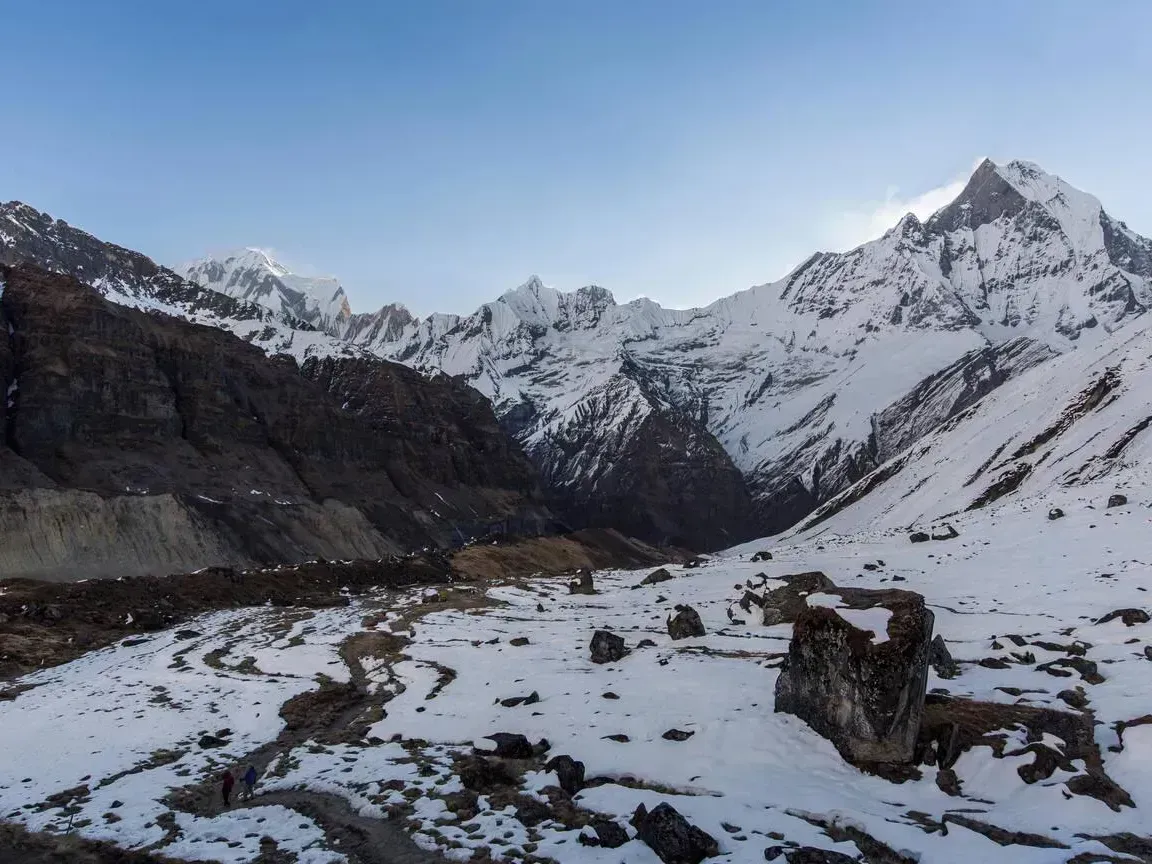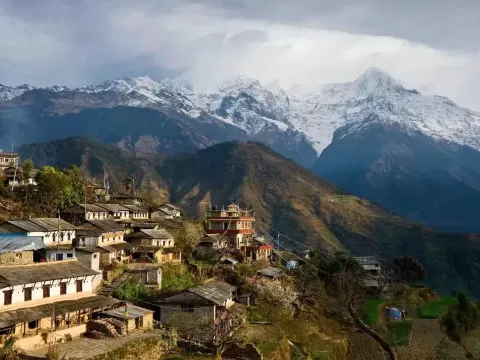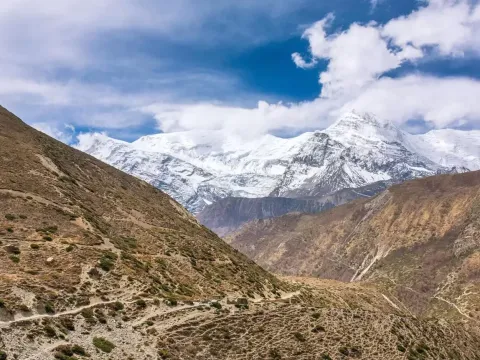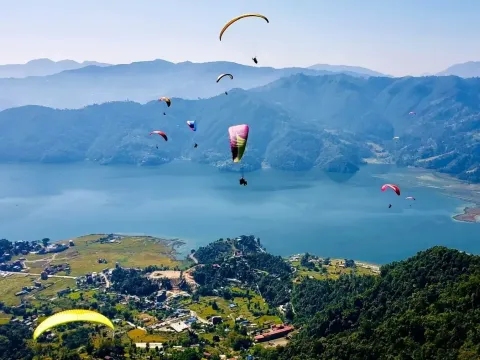The Annapurna region is a place where trekkers are treated to a blend of natural beauty, cultural heritage, and Himalayan grandeur. The region is home...

The Annapurna Base Camp Trek (ABC Trek) is one of the most popular treks in Nepal, renowned for its stunning views of the Annapurna Massif, diverse landscapes, and cultural experiences. Starting from the bustling city of Pokhara, the trail leads trekkers through lush forests, charming villages, and alpine meadows, ultimately reaching the base camp at an altitude of 4,130 meters (13,550 feet). The trek is suitable for trekkers with moderate fitness levels and offers a rich blend of natural beauty and cultural encounters. It is a great option for those looking to experience the Himalayan mountains without the extreme altitude and technical challenges of some other high-altitude treks.
Top Blogs About Trekking in the Annapurna Region
Uncover the best blogs about trekking in the Annapurna region, featuring expert advice, detailed itineraries, personal experiences, and essential tips for adventurers looking to explore the Himalayas.
Best Annapurna Ranges Treks & Tours 2024/2025
Top 9 Destinations to Explore on the Annapurna Circuit Trek
Best Time to Hike the Annapurna Circuit
Which is the Better Lake Trek in Nepal: Gokyo or Tilicho Lake Trek?
The best time to embark on the Annapurna Base Camp Trek is during the spring (March to May) and autumn (September to November) seasons. These months offer clear skies, mild weather, and breathtaking views of the surrounding peaks. The temperature is relatively comfortable, and the trekking conditions are ideal. During the winter (December to February), the trek can be challenging due to cold temperatures and snow, while the summer monsoon season (June to August) brings heavy rainfall, making the trails slippery and risky. It is recommended to avoid the monsoon season for safety reasons.
The Annapurna Base Camp Trek is considered moderate in terms of difficulty. While the trail does not require technical mountaineering skills, trekkers should be in good physical condition as the trek involves several days of walking at high altitudes. The altitude gain is gradual, which helps minimize the risk of altitude sickness, but trekkers should still be mindful of their bodies and take necessary precautions. Regular walking or hiking sessions in the months leading up to the trek will help prepare your body for the physical demands. It’s also important to acclimatize properly by taking rest days as necessary to avoid altitude-related issues.
When preparing for the ABC Trek, packing light but adequately is essential. Essential items include a good pair of trekking boots, warm layers (even in warmer months), a sleeping bag, a rain jacket, a headlamp, trekking poles, and a hydration system. A sturdy daypack will also come in handy for carrying essential items on day hikes. Remember that you will pass through teahouses along the way, so you won’t need to carry heavy camping equipment, but it’s wise to pack snacks, personal hygiene items, and any necessary medication. Trekking in the Himalayas also requires sufficient sun protection, such as a hat, sunscreen, and sunglasses.
Altitude sickness is a risk during the Annapurna Base Camp Trek, as the highest point of the trek is at 4,130 meters. However, the ascent is gradual, and with proper acclimatization, the risk can be minimized. The general rule of thumb is to ascend no more than 500 meters a day and take regular rest days. Staying hydrated and maintaining a slow and steady pace will also help your body adjust to the thinning air. If you feel symptoms such as headaches, dizziness, or nausea, it’s important to rest and descend if necessary.
About Explore Holiday Nepal:
Explore Holiday Nepal is a leading trekking agency based in Kathmandu, offering exceptional trekking and adventure experiences across Nepal, including the Annapurna Base Camp Trek. The company prides itself on its commitment to providing high-quality services, knowledgeable guides, and personalized itineraries to meet the unique needs of every traveler. With a deep understanding of Nepal’s landscapes, culture, and trekking routes, Explore Holiday Nepal ensures that all trekkers have an unforgettable and safe experience while exploring the natural beauty of the Himalayas.
Why Choose Explore Holiday Nepal:
Choosing Explore Holiday Nepal for your Annapurna Base Camp Trek means opting for a trekking experience tailored to your needs and preferences. The company offers a range of services, including professional trekking guides, porters, and well-organized accommodations, making the trek smooth and enjoyable. The team is dedicated to ensuring safety, comfort, and cultural immersion throughout the journey. Explore Holiday Nepal takes care of all the logistical aspects, including permits, transportation, and equipment rental, so that trekkers can focus solely on the adventure. Their staff is well-trained in first aid and emergency response, ensuring trekkers are well-prepared for any unforeseen circumstances.
Customized Itineraries and Packages:
Explore Holiday Nepal offers customizable trekking packages for the Annapurna Base Camp Trek. Whether you’re looking for a short and leisurely trek or a more challenging adventure, the company works with you to design an itinerary that matches your interests and time constraints. In addition to the standard route, Explore Holiday Nepal can arrange for variations such as helicopter tours, luxury lodges, or private guides. Their flexibility and personalized approach ensure that you have a comfortable and unique trekking experience, no matter your level of experience or preference.
Sustainability and Ethical Trekking:
As part of its commitment to responsible tourism, Explore Holiday Nepal emphasizes sustainable trekking practices. The company encourages trekkers to minimize their environmental impact by adhering to Leave No Trace principles and respecting local communities. By partnering with local porters and guides, Explore Holiday Nepal also supports fair wages and working conditions, contributing to the well-being of those who make trekking experiences possible. The company’s dedication to preserving Nepal's natural beauty and cultural heritage ensures that future generations will also have the opportunity to explore these magnificent landscapes.
Customer Testimonials:
Many trekkers have praised Explore Holiday Nepal for its exceptional services, from the expert guides to the seamless logistical support. Clients often highlight the warmth and professionalism of the staff, who go above and beyond to ensure safety and comfort. Whether it’s a first-time trekker or an experienced hiker, Explore Holiday Nepal consistently receives positive feedback for providing a memorable and hassle-free trekking experience. The agency’s commitment to customer satisfaction and its deep knowledge of the Annapurna region make it an excellent choice for those seeking a top-notch trekking experience in Nepal.
What is the Annapurna Base Camp Trek?
The Annapurna Base Camp Trek is a world-renowned trek that takes you deep into the heart of the Annapurna Massif in Nepal. The journey offers trekkers the chance to experience diverse landscapes, from subtropical forests to alpine meadows, and culminates at the breathtaking Annapurna Base Camp, located at 4,130 meters (13,550 feet) above sea level. The trek provides stunning views of some of the highest peaks in the Himalayas, including Annapurna I (8,091 meters), Machapuchare (6,993 meters), and several other awe-inspiring mountains. Along the way, trekkers also experience the rich culture of the local communities, including Gurung and Magar villages, adding a cultural dimension to the adventure.
The trek can be done in several variations, ranging from the standard route to more customized itineraries. The trek starts from the lakeside town of Pokhara and proceeds through a variety of terrains, including terraced fields, rhododendron forests, and scenic valleys, all while enjoying the backdrop of snow-capped peaks. It’s a moderate trek, suitable for those with a reasonable level of fitness, as it involves several days of walking at high altitudes but does not require technical mountaineering skills.
How Difficult is the Annapurna Base Camp Trek?
The Annapurna Base Camp Trek is considered a moderate-level trek, making it accessible to most trekkers with average fitness levels. The difficulty lies in the trek’s altitude, as the base camp sits at 4,130 meters (13,550 feet). While this is not extremely high compared to other Himalayan treks, trekkers still need to be cautious about altitude sickness. The trek involves long days of walking, usually between 5 to 7 hours, with ascents and descents that can be challenging. However, the ascent is gradual, and there are opportunities to acclimatize during the journey, reducing the risk of altitude sickness.
Another challenge is the terrain, which includes steep climbs and descents, as well as potential for wet and slippery conditions during the monsoon season. That said, the trails are well-maintained and trekkers can enjoy a variety of natural surroundings, from forests to mountain meadows. Most trekkers find the ABC trek doable with proper preparation, acclimatization, and a moderate pace. If you are in good health and enjoy walking, you should be able to complete the trek comfortably, although some prior experience with hiking or trekking is helpful.
What is the Best Time to Trek to Annapurna Base Camp?
The best time to trek to Annapurna Base Camp is during the spring (March to May) and autumn (September to November) seasons. These months provide the most favorable weather conditions for trekking, with clear skies, mild temperatures, and relatively stable weather. The spring months bring vibrant rhododendron blooms and lush greenery, while autumn offers crisp air and stunning mountain views, especially in the early mornings and evenings.
During these seasons, temperatures are comfortable for trekking, with daytime temperatures ranging between 10°C to 20°C (50°F to 68°F) at lower altitudes and dropping to around -5°C to -10°C (23°F to 14°F) at higher elevations, such as at Annapurna Base Camp. While it’s possible to trek in other seasons, the summer monsoon season (June to August) brings heavy rainfall and makes trails slippery, potentially leading to landslides. The winter months (December to February) are cold, with snow at higher altitudes, making the trek more challenging, although some experienced trekkers still choose to go during this time for the solitude and peaceful surroundings.
How Long Does the Annapurna Base Camp Trek Take?
The typical Annapurna Base Camp Trek usually takes about 7 to 12 days, depending on the route and the number of rest days included for acclimatization. A standard itinerary often spans 7 to 9 days of trekking, with 2 to 3 days allocated for rest and acclimatization to reduce the risk of altitude sickness. The trek typically begins in Pokhara, where trekkers drive or take a short flight to the starting point, often Naya Pul, and then gradually make their way up through the foothills to the base camp.
The trek’s duration can vary based on individual preferences. Some trekkers opt for a quicker pace, while others prefer to take it slower to fully absorb the natural beauty and culture along the way. There are also options to include side trips, such as a visit to Poon Hill for sunrise or a shorter route that avoids certain sections of the trek. Keep in mind that the pace of the trek will also depend on the group’s fitness level and health, with acclimatization being a key factor for safety and enjoyment.
Do I Need a Permit for Annapurna Base Camp Trek?
Yes, trekkers are required to obtain permits to trek to Annapurna Base Camp, as it is part of the Annapurna Conservation Area. The permits are relatively easy to obtain and can be arranged through a trekking agency or at the Nepal Tourism Board office in Kathmandu or Pokhara. The two main permits required for the Annapurna Base Camp Trek are the Annapurna Conservation Area Permit (ACAP) and the Trekkers' Information Management System (TIMS) card.
The ACAP is mandatory for all trekkers in the Annapurna region, as it helps fund conservation efforts and maintain the trekking routes. The TIMS card is used to track trekkers for safety and security purposes. Both permits are usually obtained in advance, though they can also be arranged upon arrival in Pokhara. The cost for these permits is generally affordable, and trekkers should ensure they have the necessary documentation, such as a passport and passport-sized photographs, when applying for them. The permits are checked at various points along the trail, so carrying them at all times is essential.
What is the Altitude of Annapurna Base Camp and How Can I Avoid Altitude Sickness?
The Annapurna Base Camp is located at an altitude of 4,130 meters (13,550 feet) above sea level, which makes it a high-altitude trek but not as extreme as some other Himalayan treks. However, trekking at these altitudes requires careful consideration of altitude sickness, which can occur when your body doesn’t acclimatize to the reduced oxygen levels at higher elevations. Symptoms of altitude sickness include headaches, nausea, dizziness, and fatigue, and if left untreated, it can lead to serious conditions like High Altitude Pulmonary Edema (HAPE) or High Altitude Cerebral Edema (HACE).
To avoid altitude sickness during the Annapurna Base Camp Trek, it’s essential to follow a few key guidelines:
What Type of Gear and Equipment Should I Bring for the Trek?
When trekking to Annapurna Base Camp, packing the right gear and equipment is crucial for both comfort and safety. The weather can vary significantly along the trek, from warm conditions in the lower regions to freezing temperatures at the higher altitudes. Here is a breakdown of essential gear you should bring:
Clothing:
Footwear:
Other Gear:
Are There Accommodations Along the Annapurna Base Camp Trek?
Yes, accommodation is available along the Annapurna Base Camp Trek, primarily in the form of teahouses or lodges, which are small family-run establishments providing shelter, food, and basic amenities for trekkers. The teahouses are scattered along the trekking route, usually about 5-7 hours apart, which allows trekkers to rest and recuperate overnight.
Most teahouses offer a basic standard of accommodation, with simple rooms featuring two single beds, a blanket, and a pillow. The rooms are generally not heated, so it is essential to bring a sleeping bag to stay warm, especially during the colder months. Some of the higher-altitude teahouses may have slightly more basic or less comfortable conditions due to their remote locations, but they still provide a safe and welcoming environment for trekkers.
In addition to rooms, teahouses typically offer meals like dal bhat (lentil soup with rice), momo (dumplings), and other local dishes, making it convenient for trekkers to fuel up during the trek. While the accommodations are generally comfortable, there are no luxury hotels along the route. For those looking for a more upscale experience, there are some luxury lodges available on certain parts of the trek, though these are limited and generally cater to those willing to pay a premium for extra comfort.
How Much Does the Annapurna Base Camp Trek Cost?
The cost of the Annapurna Base Camp Trek can vary based on factors such as the length of the trek, the type of accommodation, and whether you choose to trek independently or through a guided tour. On average, the trek will cost around USD 600 to USD 1,200 for a 10-12 day trek, including permits, accommodation, meals, and a guide/porter. Here’s a breakdown of the typical costs involved:
For those opting for a guided trek with Explore Holiday Nepal or another agency, the total cost will include additional services such as transport, an experienced guide, meals, and accommodation, as well as emergency insurance and first aid kits. Keep in mind that the prices will fluctuate based on group size, time of year, and specific package details.
What Food and Water Options Are Available During the Trek?
Along the Annapurna Base Camp Trek, you’ll find a wide variety of food options at teahouses along the route. Meals typically include traditional Nepali dishes such as dal bhat, momos (dumplings), thukpa (noodle soup), and rice-based meals. These are usually hearty, filling, and easy to digest after a long day of trekking. In addition to Nepali cuisine, you’ll also find familiar options like pasta, fried rice, and sandwiches, catering to international trekkers.
At higher altitudes, the menu becomes more limited, but you will still find simple meals like noodles, porridge, and instant soups. As the trek progresses, prices for food and drinks increase due to the higher cost of transporting goods to remote locations.
For water, it’s important to be cautious about hydration. The tap water available at teahouses is not safe for drinking, so trekkers are advised to carry their own purified water or use water purification tablets or filters to make sure the water is safe to drink. Bottled water is also available for purchase along the trail, but it is recommended to avoid purchasing bottled water to minimize plastic waste. Some trekkers also use a Camelbak hydration system to conveniently drink water during the trek.
In addition, it’s a good idea to bring extra snacks like energy bars, nuts, and dried fruits, which can provide an energy boost during the trek and are useful when trekking long distances between teahouses.
Can I Hire a Guide or Porter for the Annapurna Base Camp Trek?
Yes, you can hire a guide or porter for the Annapurna Base Camp Trek, and many trekkers choose to do so for added comfort, convenience, and safety. A guide will not only help with navigation but also provide valuable insights into the local culture, flora, fauna, and the mountain environment. They will ensure you stay on the right path, assist in communication with locals, and provide support in case of emergencies. Most guides are experienced and knowledgeable about high-altitude trekking, which can be very helpful in ensuring you avoid altitude sickness and other risks.
A porter can carry your heavy backpack, leaving you free to focus on the trek itself. This is especially useful if you prefer not to carry a large load and want to make the trek more comfortable. Porters typically carry up to 15-20 kg of luggage, so you'll only need to bring a smaller daypack with essentials like water, snacks, and personal items. Hiring both a guide and a porter is a common option and can significantly enhance the trekking experience by allowing you to travel more lightly and with peace of mind. You can arrange these services through trekking agencies such as Explore Holiday Nepal, which can provide both guides and porters to suit your needs.
Is the Annapurna Base Camp Trek Suitable for Beginners?
The Annapurna Base Camp Trek is considered moderate in difficulty, making it a good option for beginners with some hiking experience or those in good physical condition. While it is not as challenging as some other high-altitude treks, it still requires a reasonable level of fitness due to the long daily hiking hours and the steady ascent to higher altitudes. The maximum altitude of 4,130 meters (13,550 feet) at the base camp is not extreme, but beginners should still be aware of the risks associated with altitude sickness and be prepared to take it slow.
For absolute beginners, it’s important to know that while the trek doesn’t require technical mountaineering skills, it does require stamina and some experience with day hikes or multi-day treks. It’s advisable to start training for the trek by doing regular walks or hikes, ideally with a backpack to simulate the conditions. If you are new to trekking, it may also be beneficial to hire a guide who can help you navigate the trail and provide support throughout the journey. With proper preparation and pacing, the Annapurna Base Camp Trek is certainly achievable for beginners who are in good physical condition.
What are the Risks of the Annapurna Base Camp Trek?
While the Annapurna Base Camp Trek is generally considered safe, there are a few risks to be aware of, especially due to the high-altitude nature of the trek and the rugged terrain. Here are the key risks associated with the trek:
How Can I Prepare for the Annapurna Base Camp Trek Physically?
To prepare for the Annapurna Base Camp Trek, it’s important to build endurance, strength, and stamina to handle the physical demands of the trek. Here are some ways to prepare:
What Wildlife and Scenery Can I Expect on the Annapurna Base Camp Trek?
The Annapurna Base Camp Trek offers a rich variety of scenic beauty and diverse wildlife along the way. The trek takes you through multiple ecological zones, each with its unique flora and fauna.
Scenery:
Wildlife:
How Can I Stay Connected During the Trek?
Staying connected during the Annapurna Base Camp Trek can be a bit challenging due to the remote nature of the region, but it’s still possible to maintain communication in certain areas. Mobile networks are available in some villages along the trek, and you can use your mobile phone for calls or text messages, although the signal might be intermittent, especially at higher altitudes. Most trekkers rely on local SIM cards, which are available in Kathmandu or Pokhara, for mobile data and voice calls. This will allow you to stay connected when signal is available.
For internet access, many teahouses along the trek offer Wi-Fi services, but keep in mind that the internet can be slow and unreliable, particularly in higher-altitude areas. If staying connected is important, it’s advisable to have an offline map or GPS device and prepare for limited access to the internet. Additionally, some trekkers opt for satellite phones for emergency communication, especially in areas where mobile coverage is lacking. It’s also worth noting that radio communication is often used by guides and porters to stay in touch with base camps and other trekking groups for safety purposes.
What Should I Do in Case of Emergency on the Trek?
In case of an emergency during the Annapurna Base Camp Trek, it’s important to stay calm and follow a few key steps. The most common emergencies on trekking routes are related to altitude sickness, injuries, or health problems. Here’s what you should do:
Is Travel Insurance Required for the Annapurna Base Camp Trek?
Yes, travel insurance is highly recommended and often required for the Annapurna Base Camp Trek. This is because the trek involves risks such as altitude sickness, injury, or sudden changes in weather, and medical evacuation can be costly. A good travel insurance policy will provide coverage for a range of potential issues, including:
Ensure that your travel insurance policy specifically covers trekking at high altitudes and provides for emergency evacuation. Most trekking agencies, including Explore Holiday Nepal, may ask for proof of insurance before confirming your booking, and it is always a good idea to carry a copy of your insurance policy during the trek.
What Is the Cancellation Policy for Annapurna Base Camp Trek with Explore Holiday Nepal?
The cancellation policy for the Annapurna Base Camp Trek with Explore Holiday Nepal typically depends on the time of cancellation relative to your scheduled trek. While the exact terms may vary, here’s a general outline of what you can expect:
It’s important to note that travel insurance that covers cancellations may help recover some or all of your costs if you need to cancel your trek due to unforeseen circumstances. Always review the specific cancellation terms and conditions with Explore Holiday Nepal when booking your trek to ensure you understand the policies.
How Do I Book the Annapurna Base Camp Trek with Explore Holiday Nepal?
Booking the Annapurna Base Camp Trek with Explore Holiday Nepal is a straightforward process. Here’s a step-by-step guide on how to book:
Explore Holiday Nepal ensures a seamless and well-organized trekking experience, and they can accommodate individual needs and preferences, ensuring that your Annapurna Base Camp Trek is enjoyable, safe, and memorable.

The Annapurna region is a place where trekkers are treated to a blend of natural beauty, cultural heritage, and Himalayan grandeur. The region is home...

The Annapurna Circuit Trek is one of the most renowned and diverse trekking routes in the world, known for its stunning views of the Annapurna mountai...

Nepal, a land of timeless beauty, is poised to offer travelers an even richer and more immersive experience in 2025 and 2026. With increased focus on...
